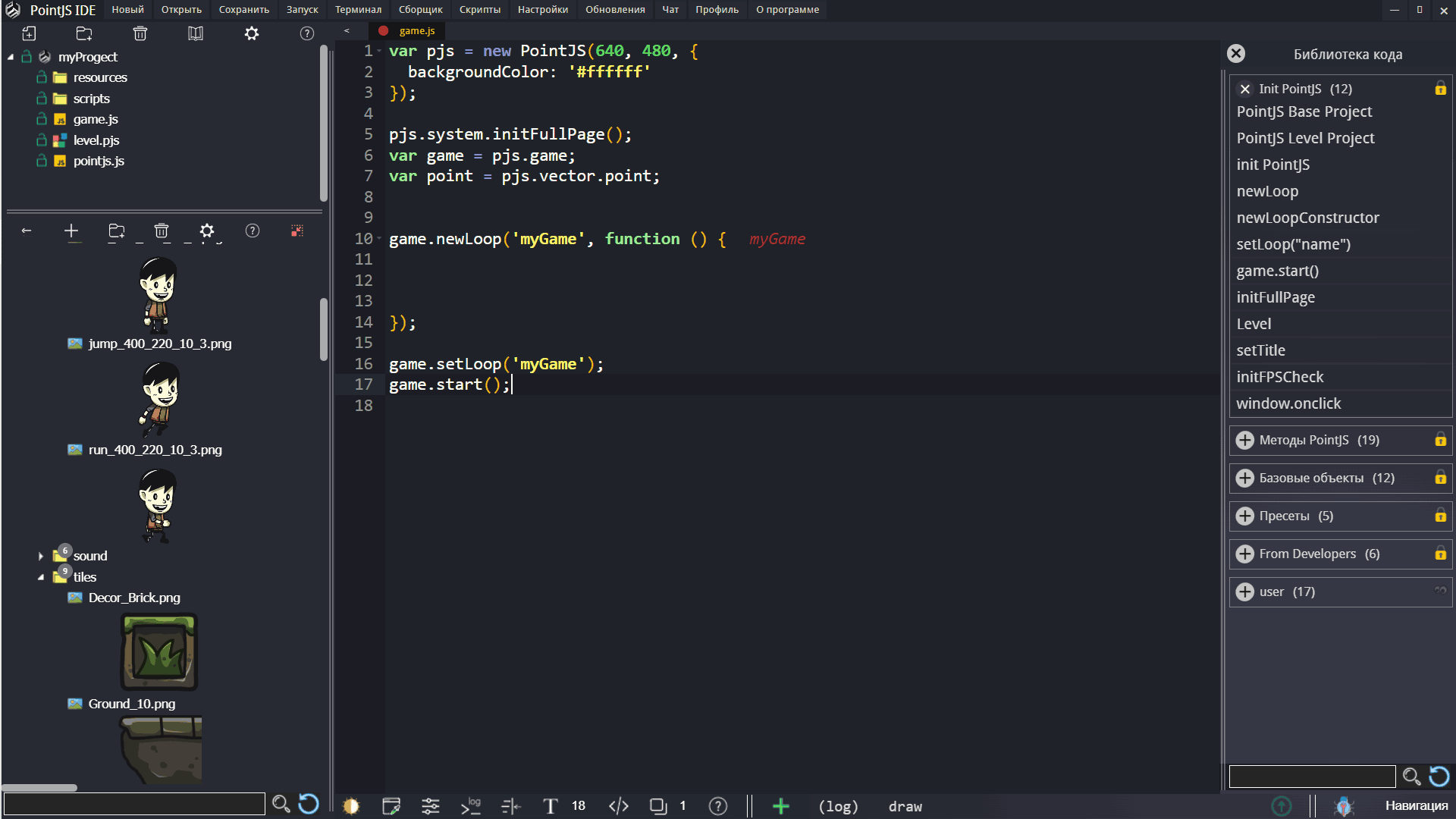Important! If you are using PointJS, it is not advisable to connect other engines (jQuery, Angular, etc.) to it. PointJS intercepts many system events and affects the entire page. To prevent engines from interfering with each other, use an iframe.
Initializing the game engine
Example:
You can expand the game to full screen, then the WIDTH and HEIGHT values will be ignored
The following methods are now available:
If the method is called frequently, then it is customary to make a reduction. Let's create, for example, a key variable, in which we will remove all keyboard methods, and immediately activate it with the initControl command. We will make the same reduction for the main game method
This form of recording is acceptable, but takes up more space :)
Now in the game cycle, you can quickly access the keyboard methods.
The game loop, where all events are processed, is created by the newLoop command, which is located in the game methods. Let me remind you that game is an abbreviation (like what we created for the keyboard).
And these two commands allow you to select (set active) one of the game cycles and start the game
In the end, we did it:
Initializing the game engine
const pjs = new PointJS(WIDTH, HEIGHT, STYLES); //WIDTH - width of the game area //HEIGHT - height of the game area //STYLES - styles, background, margins
Example:
const pjs = new PointJS(640, 480, {
backgroundColor: '#ffffff'
});
You can expand the game to full screen, then the WIDTH and HEIGHT values will be ignored
//Expand the game to full screen pjs.system.initFullPage();
The following methods are now available:
//Creating game objects and game loops
pjs.game
//Working with the game level map level.js
pjs.levels;
//Camera Control
pjs.camera;
//Keyboard Event Handler
pjs.keyControl;
//Mouse Event Handler
pjs.mouseControl;
//The handler of touch taps
pjs.touchControl;
//Settings and system methods
pjs.system;
//Vector mathematics and space
pjs.vector;
//Numerical methods and random values
pjs.math;
//Color generators, encoders
pjs.colors;
//Methods of drawing on stage
pjs.brush;
//HTML Audio надстройка
pjs.audio;
//Managing external resources
pjs.resources;
//Loading and processing sprite animations
pjs.tiles;
//OOP methods. Counters, timers, cycles
pjs.OOP;
If the method is called frequently, then it is customary to make a reduction. Let's create, for example, a key variable, in which we will remove all keyboard methods, and immediately activate it with the initControl command. We will make the same reduction for the main game method
const key=pjs.keyControl.initControl(); const game = pjs.game;
This form of recording is acceptable, but takes up more space :)
const key = pjs.keyControl; key.initControl();
Now in the game cycle, you can quickly access the keyboard methods.
if (key.isPress("D")) {
//game code
}
if (key.isInputMode()) {
//game code
}
The game loop, where all events are processed, is created by the newLoop command, which is located in the game methods. Let me remind you that game is an abbreviation (like what we created for the keyboard).
game.newLoop('myGame', function () {
// game code
});
//myGame - game loop name
And these two commands allow you to select (set active) one of the game cycles and start the game
game.setLoop('myGame');
game.start();
In the end, we did it:
const pjs = new PointJS(1280, 720, {
backgroundColor: '#ffffff'
});
pjs.system.initFullPage();
const game = pjs.game;
const key=pjs.keyControl.initControl();
game.newLoop('myGame', function () {
if (key.isPress("L")) {
console.log('Hello Wold');
}
});
game.setLoop('myGame');
game.start();
You don't have to do all this, because when you create a new project, the PointJS IDE already has a base code template
